|
|
Published February 8th, 2017
|
Falling trees threaten Lamorinda residents
|
|
| By John T. Miller |
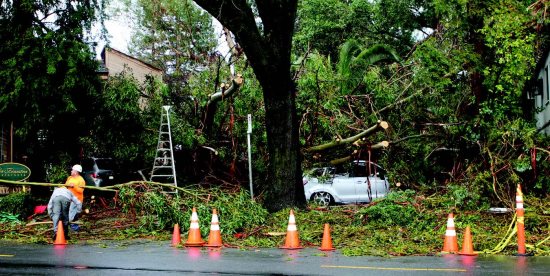 |
| The fallen eucalyptus tree damaged multiple cars and covered the parking lot in front of La Finestra Restaurant in Lafayette. Photo Gint Federas |
A spate of falling trees in Lamorinda over the past month caused extensive damage and raised concern over future harm from overwrought trees.
 A eucalyptus fell on Lafayette Circle, damaging several cars in the La Finestra parking lot and blocking the roadway, while a Valley Oak toppled at the corner of Burton and Lucas Drives, causing extensive damage to one of the homes on a corner lot.
A eucalyptus fell on Lafayette Circle, damaging several cars in the La Finestra parking lot and blocking the roadway, while a Valley Oak toppled at the corner of Burton and Lucas Drives, causing extensive damage to one of the homes on a corner lot.
 Mike Moran, Director of Public Works for the City of Lafayette, expressed relief that no one was killed. "The issue of falling trees is keeping me up nights," he said.
Mike Moran, Director of Public Works for the City of Lafayette, expressed relief that no one was killed. "The issue of falling trees is keeping me up nights," he said.
 The popular perception is that the combination of five years of prolonged drought, along with the recent above-average rainfall, led to the trees' demise. However, many other factors contribute to the danger posed by falling trees.
The popular perception is that the combination of five years of prolonged drought, along with the recent above-average rainfall, led to the trees' demise. However, many other factors contribute to the danger posed by falling trees.
 "Many of the homes in Lafayette were built 60-70 years ago," said Moran. "The trees were there before and are no longer in the best conditions to grow. Many are now near sidewalks or roadways and, like animal species, have lost their habitat."
"Many of the homes in Lafayette were built 60-70 years ago," said Moran. "The trees were there before and are no longer in the best conditions to grow. Many are now near sidewalks or roadways and, like animal species, have lost their habitat."
 Saranap resident John Traverso, owner of Traverso Tree Service and a certified arborist, estimated that the oak tree that fell was an estimated 250 years old and suffered from the street being moved 10 feet closer. In addition, he added, all water going down a crack in the gutter went beneath the tree. Roots had been damaged beneath the upper layer and rotted out.
Saranap resident John Traverso, owner of Traverso Tree Service and a certified arborist, estimated that the oak tree that fell was an estimated 250 years old and suffered from the street being moved 10 feet closer. In addition, he added, all water going down a crack in the gutter went beneath the tree. Roots had been damaged beneath the upper layer and rotted out.
 "From the surface, no one could have seen the damage to the oak, but the eucalyptus was a different matter." said Moran. "It was clearly overgrown and prime for a fall."
"From the surface, no one could have seen the damage to the oak, but the eucalyptus was a different matter." said Moran. "It was clearly overgrown and prime for a fall."
 Public Works Director Edric Kwan of Moraga says that the town has been pretty lucky so far, but there was a big tree that fell on Augusta Drive near the Country Club.
Public Works Director Edric Kwan of Moraga says that the town has been pretty lucky so far, but there was a big tree that fell on Augusta Drive near the Country Club.
 "Homeowners should be aware that they are responsible for the trees around their property," warned Kwan. "Public Works will remove a tree that is blocking a roadway, but the property owner will have to pay for that service." He added that the homeowner's insurance usually covers the cost.
"Homeowners should be aware that they are responsible for the trees around their property," warned Kwan. "Public Works will remove a tree that is blocking a roadway, but the property owner will have to pay for that service." He added that the homeowner's insurance usually covers the cost.
 Precautions for Homeowners
Precautions for Homeowners
 Moran also cautions that property owners are responsible for the maintenance of trees adjacent to their property (ie. sidewalk trees).
Moran also cautions that property owners are responsible for the maintenance of trees adjacent to their property (ie. sidewalk trees).
 "Many of the older and bigger eucalyptus and pine trees have problems and are already on the way out," said Moran. "The eucalyptus have shallow foundations and should be pruned regularly, while many pine trees have been decimated by bark beetles."
"Many of the older and bigger eucalyptus and pine trees have problems and are already on the way out," said Moran. "The eucalyptus have shallow foundations and should be pruned regularly, while many pine trees have been decimated by bark beetles."
 One large problem with existing trees is too much landscape irrigation. Direct water on tree trunks, growing lawn around trees and over mulching can all compromise a tree. Traverso recommends keeping water at least 10 feet away from the trunk.
One large problem with existing trees is too much landscape irrigation. Direct water on tree trunks, growing lawn around trees and over mulching can all compromise a tree. Traverso recommends keeping water at least 10 feet away from the trunk.
 Traverso estimates it may take up to three to five years for problems to decrease from the past drought. "One good winter may actually contribute to further failures. Early storms brought down the weaker and smaller trees, while worse storms are bringing down bigger ones."
Traverso estimates it may take up to three to five years for problems to decrease from the past drought. "One good winter may actually contribute to further failures. Early storms brought down the weaker and smaller trees, while worse storms are bringing down bigger ones."
 Traverso also mentioned a large problem for tree owners: summer (or sudden) limb drop in warmer weather. "Throw in 100-degree heat and a drop in the weather at night and it can cause a defect in the branch to break and fall."
Traverso also mentioned a large problem for tree owners: summer (or sudden) limb drop in warmer weather. "Throw in 100-degree heat and a drop in the weather at night and it can cause a defect in the branch to break and fall."
 Traverso and Moran both suggest that if homeowners have any doubt about the condition of their trees they should consult a qualified arborist for an evaluation. Most companies would evaluate and submit a bid for free. People can also check the www.treesaregood.com website for a qualified tree risk assessor from the International Society of Arboriculture.
Traverso and Moran both suggest that if homeowners have any doubt about the condition of their trees they should consult a qualified arborist for an evaluation. Most companies would evaluate and submit a bid for free. People can also check the www.treesaregood.com website for a qualified tree risk assessor from the International Society of Arboriculture.

|
 Danger of Falling Trees -What to Look For: Danger of Falling Trees -What to Look For:

 � Uncorrected Leans: The upright growth of the tree has been compromised. This could happen for a variety of reasons (shade constraints, trauma, etc.). To check if a tree is leaning more, drive two screws into different levels of tree and check with a digitalized level. Measure again periodically to see if there is increased angle. � Uncorrected Leans: The upright growth of the tree has been compromised. This could happen for a variety of reasons (shade constraints, trauma, etc.). To check if a tree is leaning more, drive two screws into different levels of tree and check with a digitalized level. Measure again periodically to see if there is increased angle.
 � Fungi: Various fungi can cause damage to the tree's trunk. Most commonly, Armillaria, sometimes called the oak root fungus, can infect the roots. Because of this, detection is difficult unless characteristic mushrooms are produced around the base of the tree or symptoms become obvious in the crown or on the lower stem. � Fungi: Various fungi can cause damage to the tree's trunk. Most commonly, Armillaria, sometimes called the oak root fungus, can infect the roots. Because of this, detection is difficult unless characteristic mushrooms are produced around the base of the tree or symptoms become obvious in the crown or on the lower stem.
 Generally, the foliage thins and discolors, turns yellow, then brown; branches die back; and shoot and foliar growth are reduced. Generally, the foliage thins and discolors, turns yellow, then brown; branches die back; and shoot and foliar growth are reduced.
 On large, lightly infected or vigorous trees, crown symptoms develop over a number of years until the trees die. Conifers, particularly Douglas fir and western larch, frequently produce a larger-than-normal crop of cones, known as stress cones, shortly before they die. On large, lightly infected or vigorous trees, crown symptoms develop over a number of years until the trees die. Conifers, particularly Douglas fir and western larch, frequently produce a larger-than-normal crop of cones, known as stress cones, shortly before they die.
 On most conifers, the infected portions of the lower stems are somewhat enlarged and exude large amounts of resin. Infected portions of the roots frequently become heavily encrusted with resin, soil and fungal tissue. Other fungi can include brown rot and shelf conks, which resemble seashells protruding from the trunk. On most conifers, the infected portions of the lower stems are somewhat enlarged and exude large amounts of resin. Infected portions of the roots frequently become heavily encrusted with resin, soil and fungal tissue. Other fungi can include brown rot and shelf conks, which resemble seashells protruding from the trunk.
 � Drought stress: Symptoms are often the same as fungal damage, but without the presence of fungi. � Drought stress: Symptoms are often the same as fungal damage, but without the presence of fungi.
 � Buried trunk: The trunk resembles a buried telephone pole. This can be the result of overmulching or excessive watering. Digging around the base may reveal root damage. � Buried trunk: The trunk resembles a buried telephone pole. This can be the result of overmulching or excessive watering. Digging around the base may reveal root damage.
 � Root restriction: Factors such as nearby concrete, foundations, retaining walls, pathways, etc., may limit root extension. Girdling roots may be found wrapping around the base of the tree. � Root restriction: Factors such as nearby concrete, foundations, retaining walls, pathways, etc., may limit root extension. Girdling roots may be found wrapping around the base of the tree.
 � Excessive pruning. Improper or excessive pruning can compromise a tree and lead to failure. Over-thinning the interior of the tree (called lions-tailing), unbalances the crown causing future growth toward the ends of remaining branches. This shifts the center of gravity higher where wind speed is greater. Branches may break more easily in storms or under their own weight. � Excessive pruning. Improper or excessive pruning can compromise a tree and lead to failure. Over-thinning the interior of the tree (called lions-tailing), unbalances the crown causing future growth toward the ends of remaining branches. This shifts the center of gravity higher where wind speed is greater. Branches may break more easily in storms or under their own weight.
 � Multiple trunks: Trees with more than one dominate trunk can have a tendency to split, causing major portions of the tree to fall. � Multiple trunks: Trees with more than one dominate trunk can have a tendency to split, causing major portions of the tree to fall.
 � Vine growth: Vines can cause structural problems. Added weight can break branches or cause tree to topple. Debris and moisture can be trapped against the trunk leading to fungal and bacterial diseases and structural decay at the base of the tree. � Vine growth: Vines can cause structural problems. Added weight can break branches or cause tree to topple. Debris and moisture can be trapped against the trunk leading to fungal and bacterial diseases and structural decay at the base of the tree.
 Sources: U.S. Department of Agriculture Forest Service; Urban Tree Foundation; The Britton Fund; Midwestern Trees; John Traverso, Arborist Sources: U.S. Department of Agriculture Forest Service; Urban Tree Foundation; The Britton Fund; Midwestern Trees; John Traverso, Arborist |
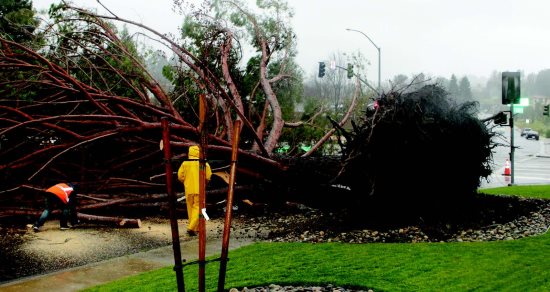 |
| This tree fell onto St. Andrews Drive near Moraga Way in Moraga Photos Gint Federas |
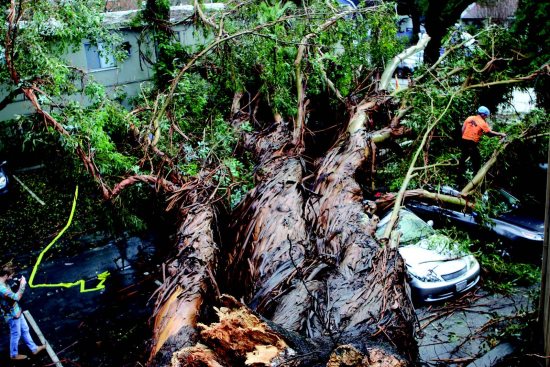 |
| The massive trunk of the fallen eucalyptus tree |
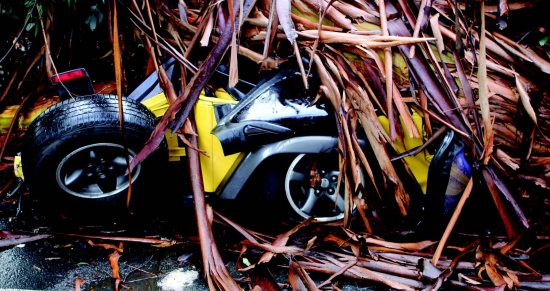 |
| The remains of a Jeep Wrangler car crushed by the eucatiptus tree was parked in front of La Finestra Restaurant |
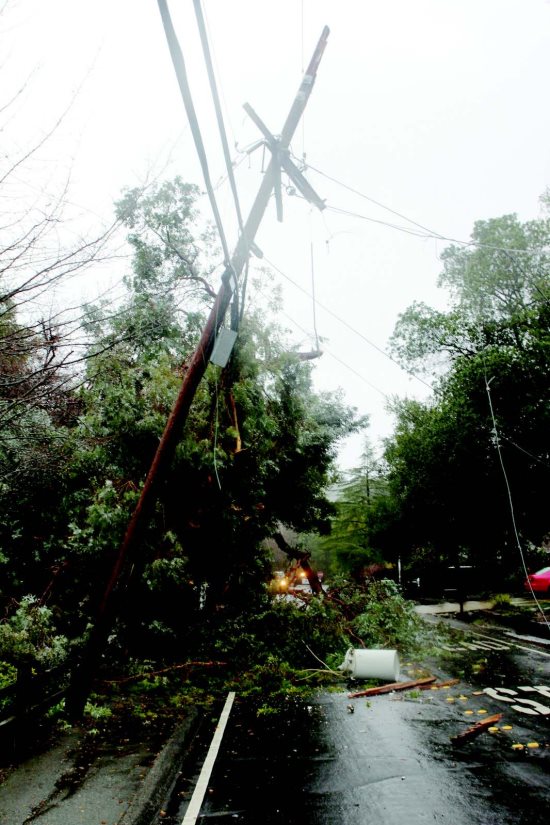 |
| Many power lines are in danger to be damaged by falling trees like this one on Reliez Valley Road. |
 |
| |
|
|
|









